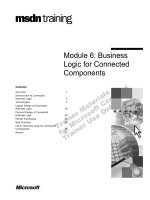module 6 change design may15 0
Bạn đang xem bản rút gọn của tài liệu. Xem và tải ngay bản đầy đủ của tài liệu tại đây (1.19 MB, 26 trang )
Supporting change through
Capacity Development
Module 6
Designing the change process
Before talking about design: how do people change
Want to
Intention
Able to
Behaviour
Situation
Have to
Results
This Module
•
Discusses design considerations for supporting a capacity development and change
programme
•
Considers what strategies can be used
•
Considers what inputs
can be applied
•
Considers the respective
roles
CD/ Change Process
Contextual factors beyond influence
Capacity
Recurrent inputs
Outputs
CD processes
Internal
resources
r
uppo
CD s
t
Contextual factors and actors within influence
Outcomes
Wider impact
Theories of Change
•
About How to arrive at Capacity Results?
–
–
From the WHAT to the HOW….
A strategy to get from where we are to where we want to be?
•
Highlights our understanding of how change happens – what it will take to deliver results.
•
Builds on insights from earlier diagnostic work and dialogue.
–
–
–
–
–
Political economy, incentives and opportunities for change
Change readiness, ownership and demand for support
The nature of the capacity challenge; simple or transformational, supply side or demand side
Single organisation or multiple entities and stakeholders
What has worked before and possible role for external assistance
Questions to ask
•
How to engage: How directive, how facilitative?
•
What opportunities for Quick Wins: versus longer processes?
•
Where and with whom best to engage and what mix: selecting “action fields”?
•
What inputs required: What combination is appropriate?
•
Roles and responsibilities of Partners: Who does what?
•
What kind of programme implementation arrangements: Leadership, oversight and accountability?
Complexity and Capacity
Far From Agreement
Chaotic
Complex
▲
▲
Complicated
Complex
Simple
Complicated
▲
Close to Agreement
Close to Certainty
►►►
Complex
Far From Certainty
The more complex, the more moments for reflection and adjustment
Complex
Complicat
Simple
ed
e.g.
e.g.
e.g.
•
•
•
•
•
Sector reform
State Building
e.g.
•
•
•
Incrementa
Single
Business
Organisatio
Process
nal change
Post-Conflict
Post-Conflict
Emergent
Justifcation, ‘Hope’
•
•
l
•
Planned
Attribution
Attribution
Contributio
n
Understanding the connections between inputs and outcomes
Analysing four “action fields” for promoting change
Focus on the ‘functional-rational’
Focus on the ‘political’ dimension
dimension
Focus on factors within the
1. Getting the job done
organisation(s)
Focus on factors in the external
environment
2. Getting the power right
and accommodating interests
3. Creating an ‘enabling
4. Forcing change in the
environment’ for doing the
internal power relations
job
9
Questionnaire results:
Colours of change
Colour images
Yellow
Same wavelength = change
Difficult to predict
Blue
Rational design
Management forces change
Red
Management attention
Soft aspects
Green
Trial and error
Ownership and support
White
Change is autonomous
Outside influence no effect
Main orientation
Yellow
Bring key players together and come to a consensus of best feasible solution.
Blue
Analyse situation and rationally plan for the pre-determined result. Implement
accordingly.
Red
Provide incentives and motivate for a ‘best fit’ between people and
organisation.
Green
Create awareness and systematically develop joint learning opportunities.
Coach for results.
White
Create space for self-organised change. Remove blockages, promote energy.
Criteria for effect/success
Yellow
Mutual interests, consensus, a ‘good deal’, no (more) resistance.
Blue
Results achieved, plan has been implemented, clear responsibilities.
Red
People feel connected/at home/taken serious, good atmosphere and
cooperation, proud.
Green
Staff experiment and ask for feedback, want to learn, good experiences are
shared.
White
People adapt to new situations, organise themselves outside formal structure,
energy.
Ideals and pitfalls
Yellow
I = mutual interest is primary
P = no real action (only on paper)
Blue
I = everything can be controlled and managed
P = relationships and emotions are neglected
Red
I = the right man in the right place
P = resisting staff and powerful structures
Green
I = anything can be learned
P = rules and assignments also work
White
I = progress will emerge by itself
P = laissez-faire, chaos
Will not work when ...
Yellow
Blue
Weak leaders, too much dissent, no urgency or ambition
Very dynamic environment, difficult to acquire expertise, unclear conditions and
means
Red
Staff do not wish to take responsibility, leaders cannot provide trust, little in
common
Green
Little understanding towards change, hidden conflicts, no safety, leaders not
accepted
White
Little dynamism and confrontation, no confidence/guts, too dependent
Conclusions for working on your change plan
Three types of change
Dramatic change
Provides gradual order
s
Sy
t
em
a
ti c
ch
g
an
e
Provides impulses
Area of
revolution
Area of
reform
Area of rejuventation
Organic change
Provides enthusiasm
Time and degree of difficulty for different levels of change
ORGANISATIONAL OR GROUP BEHAVIOUR
INDIVIDUAL BEHAVIOUR
DEGREE OF
DIFFICULTY
ATTITUDE
KNOWLEDGE
TIME
Consider at the start:
•
•
•
How to support internal drivers of change
How to link with, relate to and build on previous or existing initiatives
What is happening in other parts of the system and how these interventions might
interact with them
•
•
How interventions can be followed up for sustainability
What to do first – sequencing
In all this: work first with individuals and their relations, then the systems behind them
Actors and roles
• Initiators
Initiators
• Sponsors
Sponsors
• Protagonists
Protagonists
• Antagonists
Antagonists
• Drivers
Drivers
• Implementers
Implementers
• ‘Victims’
‘Victims’
Analysing four action fields for promoting change
Focus on the ‘functional-rational’
Focus on the ‘political’ dimension
dimension
Focus on factors within the
1. Getting the job done
organisation(s)
2. Getting the power right and
accommodating interests
Focus on factors in the external
3. Creating an ‘enabling environment’
4. Forcing change in the power
environment
for doing the job
relations
Institutional
Hard capacity needs
•
•
Formulation of enabling legislation
Establishing necessary institutions to oversee
Soft capacity needs
•
•
legislation enactment and implementation
•
(sector) results framework
Public awareness campaigns
Lobbying and advocacy with political
decision makers
•
Creating sector consensus
Organisat-ional
•
•
Development of policies and procedures
Development of strategic and operational
plans
Individual
•
ICT infrastructure
•
Training to upgrade technical skills
•
•
•
•
Facilitation of conflict resolution
Leadership development programme
Introduction of reflective learning practices
Creating a results orientation
22
Selecting a balanced set of interventions
NGO
Skills
Learning
support
development
Ministry
programme
capacity
Sector
Education
coordination
system
Trade
Legal
regulations
framework
Etc., etc.
Lesson learned:
Technical skills, laws, procedures or policies are rarely, if ever, enough on their own. Behaviour, attitudes
and informal structures are usually as important
No single tool can provide the answer to a complex need
23
Who Does What – the partner country?
•
Focus frst on what the partner country will bring to the process.
–
–
the change management responsibility; leadership
the practical actions the partner will do (time, money, logistics, staff, activities)
•
•
Only then consider need for external support including that of the Commission
What External Partners can bring
•
Many roles: advice, knowledge-ideas, funding, hands on deck, linkages, mentorship, sounding
board?
•
Think beyond TC/TA: consider if other instruments can help e.g. NGO support, budget support,
facilitate dialogue, twinning, (regional) knowledge exchange, peer support, pilotsexperimentation
•
Inputs without an influencing or engagement strategy are likely to be ineffective









